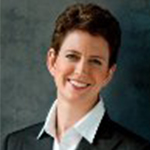Yesterday, February 24, 2013, approximately 300 members of the New York City dance community gathered at the Gibney Dance Center on Broadway for the annual, one day “Dance/NYC Symposium.”
Dance/NYC’s mission is to bolster the support structure for dance in the New York City metropolitan area, serving as a voice and guide for dance artists and managers. Dance/NYC works in alliance with Dance/USA, the national service organization for professional dance, to achieve this mission and execute on core program areas.
Dance/NYC is not a membership organization, but rather a constituent service entity. It services 5,000+ individual dance artists, 1,200+ dance-making entities, 500+ nonprofit dance companies, the general public and visitors to New York with respect to dance, students and educators, and government and civic leaders and researchers.
The atmosphere of camaraderie and collaboration at the Symposium, from start to finish, was palpable. The usual networking that takes place at these kinds of events was apparent and constant. The information exchange between individuals and between panel members and audience was valuable and actionable. Yet, while the symposium was devoted to issues and challenges of the dance world, the commentaries from panel members and questions from the symposium participants could just as easily have been applied to other sectors of the world of the performing arts.
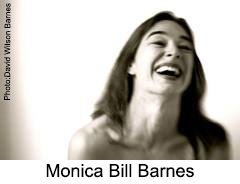 As choreographer Monica Bill Barnes put it: “There are no new steps, only different combinations.” Similarly, the parallel is: there are no new issues, only different arts disciplines.
As choreographer Monica Bill Barnes put it: “There are no new steps, only different combinations.” Similarly, the parallel is: there are no new issues, only different arts disciplines.
Part of the reason for the universal themes expressed during the day was the choice of topics and speakers. For example, while there were a few side panels (such as a Legal Clinic), the main room in the Gibney Dance Center hosted the following topics: “Touring and the Marketplace(s),” “Digital and Media Space for NYC Dance,” “Meet the Funders: (Inter)national Giving for NYC Dance,” “Dance Education in a Global City: the Future of NYC Dance,” “and “Turn Up the Volume –Become a Dance Advocate.” Substitute any of the other sectors in the performing arts field into these session titles and it would fit. Your choice.
The 45+ speakers were not only of quality, but could also speak to issues beyond those specific to the dance sector. Among the speakers were:
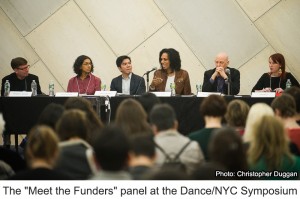 Mario Garcia Durham, President & CEO, Association of Performing Arts Presenters (Moderator)
Mario Garcia Durham, President & CEO, Association of Performing Arts Presenters (Moderator)- Virginia Johnson, Artistic Director, Dance Theatre of Harlem
- Joseph V. Melillo, Executive Producer, Brooklyn Academy of Music
- Andrea Snyder, Co-Director, American Dance Abroad
- Elizabeth Scott, Chief Media and Digital Officer, Lincoln Center for the Performing Arts
- Ellen Bar, Director of Media Projects, New York City Ballet
- Norton Owen, Director of Preservation, Jacob’s Pillow
- Douglas Sonntag, Director of Dance, National Endowment for the Arts (Moderator)
- Adam Bernstein, Deputy Director, Programs, Mid-Atlantic Arts Foundation
- Michelle Coffey, Executive Director, Lambent Foundation
- Stanford Makishi, Deputy Director and Director of Programs, Asian Cultural Council
- Sara Nash, Program Manager, New England Foundation for the Arts’ National Dance Project
- Marya Wethers, Program Manager, New York Live Arts
Across the board, universal issues of arts funding, advocacy, audience building, use of digital media, performance in traditional and non-traditional venues, and education of young audiences were iterated and reiterated throughout the day. Two words that echoed throughout the day were “relationships” and “funding.” With regard to the latter, two reprints in the Dance/NYC’s symposium kit centered on re-framing the funding issue: “More Dance Companies Scrapping the Old Funding Model” (The Wall Street Journal, August 30, 2012) and “Dance is Kickstarter’s most successful category” (The Washington Post, August 24, 2012) pointed to the aggressive stance of dance companies and choreographers when it comes to current economic realities.
Among the panel speaker commentaries that stood out to this listener:
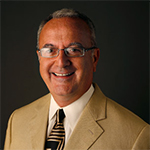 “Postcards don’t work anymore. A one-page letter explaining why you and your company should perform in a particular place is more effective. . . .Research, research, research. Find out who you are attempting to contact and what their needs are.” Joseph V. Melillo, Executive Producer, Brooklyn Academy of Music
“Postcards don’t work anymore. A one-page letter explaining why you and your company should perform in a particular place is more effective. . . .Research, research, research. Find out who you are attempting to contact and what their needs are.” Joseph V. Melillo, Executive Producer, Brooklyn Academy of Music
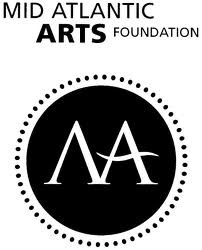 “Read the guidelines. Read the guidelines. Respond to the questions being asked in the request for proposals. Shorter is better than longer. Don’t present pages and pages and pages of text. The work sample is extremely important.” These admonitions were iterated by Adam Bernstein, Deputy Director, Programs, Mid-Atlantic Arts Foundation and Douglas Sonntag, Director of Dance, National Endowment for the Arts.
“Read the guidelines. Read the guidelines. Respond to the questions being asked in the request for proposals. Shorter is better than longer. Don’t present pages and pages and pages of text. The work sample is extremely important.” These admonitions were iterated by Adam Bernstein, Deputy Director, Programs, Mid-Atlantic Arts Foundation and Douglas Sonntag, Director of Dance, National Endowment for the Arts.
“A picture is worth a thousand words. Visualize. Visualize. Visualize.” Elizabeth Scott, Chief Media and Digital Officer, Lincoln Center for the Performing Arts.
Douglas Sonntag, Director of Dance, National Endowment for the Arts (NEA), also pointed out that the NEA has just started going all digital when it comes to submitting grant proposals. As he put it: “Now adjudicators will view your proposals online in their jammies at midnight,” meaning the traditional model of peer review panelists meeting in one room at one time, with all the attendant costs attached to this model, and the bonding that might take place among panelists is a thing of the past.
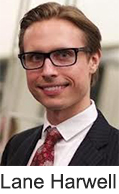 Lane Harwell is Executive Director of Dance/NYC. Prior to joining the organization, Lane was the director of development at New York’s arts-wide advocacy group, the Alliance for the Arts. His lifelong history in the arts includes a performance career with American Ballet Theatre Studio Company and management experience in diverse theatre and service contexts. He holds an MBA from Columbia Business School, and an MA from the University of California (Berkeley), and a BA from Princeton University.
Lane Harwell is Executive Director of Dance/NYC. Prior to joining the organization, Lane was the director of development at New York’s arts-wide advocacy group, the Alliance for the Arts. His lifelong history in the arts includes a performance career with American Ballet Theatre Studio Company and management experience in diverse theatre and service contexts. He holds an MBA from Columbia Business School, and an MA from the University of California (Berkeley), and a BA from Princeton University.
Harwell added his own perspective on the issues including: “The challenge mindset, the opportunity to think about the opportunities that are out there. Financial resources are a challenge for the sector, but there’s also opportunities to think creatively about new kinds of revenue streams. The audience question and how to bring more people into the theatre is a challenge, but there’s also an opportunity to look at new kinds of audiences. The session on digital media and space presented new opportunities to connect with audiences.
“In the wake of Hurricane Sandy there were unanticipated costs that really created a challenge for the sector because they’re so economically fragile. We tried to address that by securing emergency funds and getting that out to the field.” Dance/NYC’s advocacy resulted in funding, even though it was two months after the fact. 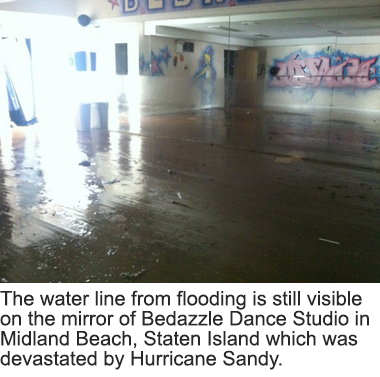 Dan Wakin reported in the New York Times: “Among the huge outpouring of relief for damages from Hurricane Sandy, nearly two months after it hit, a modest effort is on the horizon for the shoestring but vibrant world of modern dance in New York City. Starting in early January checks from $1,000 to $5,000 will go out to companies, choreographers and theatres knocked back on their heels by the destruction and flooding.” (“Modern Dance Groups to Get Hurricane Sandy Aid,” NYT, December 25, 2012).
Dan Wakin reported in the New York Times: “Among the huge outpouring of relief for damages from Hurricane Sandy, nearly two months after it hit, a modest effort is on the horizon for the shoestring but vibrant world of modern dance in New York City. Starting in early January checks from $1,000 to $5,000 will go out to companies, choreographers and theatres knocked back on their heels by the destruction and flooding.” (“Modern Dance Groups to Get Hurricane Sandy Aid,” NYT, December 25, 2012).
“Dance is ephemeral. We saw in the wake of Hurricane Sandy the impact on dance is not one that can be measured the same in the way as the visual arts where there was actual damage to work and how that plays out in the marketplace. We believe that the dance community is more economically fragile than many” Harwell added.
I asked Harwell what he thought the reason was for the strong feeling of camaraderie and collaboration at the Symposium. He answered: “In part the people who were there were self-selecting. They were already primed to engage in discussion with their colleagues. They were motivated. Part of the work we’re trying to do is create these spaces for the community to connect. One of the opportunities for a stronger field is a pooling of ideas and resources and events like the Symposium are part of that. To the larger question, the difference between dance and music, perhaps it has to do with the reality of group training, or perhaps it has to do with the many ways that the art form connects people and ideas. Dance already involves music and set design, and bodies in space. Creating dance is also a collaborative act between choreographer and dancer.”
Harwell also pointed to the fact that the highly collaborative dynamic in the dance world was because the demographic of this performing arts sector was largely female and that factor might also contribute to the strong sense of community.
Given the effectiveness of the Dance/NYC Symposium, the question then becomes: why isn’t there a Music/NYC? Yes, there are many, yet disparate organizations in the New York City that deal with certain aspects of the New York City music scene—too many to list in this blog. But wouldn’t there be an advantage, especially economically, to all the stakeholders in the NYC music scene if there were such an organization?
Please write to me at meiienterprises@aol.com if you have any comments on this or any other of my blogs.
Eugene Marlow, Ph.D.
February 25, 2013
©2013 Eugene Marlow



